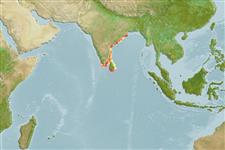>
Scombriformes (Mackerels) >
Trichiuridae (Cutlassfishes) > Trichiurinae
Etymology: Lepturacanthus: Greek, leptos = thin + Greek, oura = tail + Greek, akantha = thorn (Ref. 45335).
Environment: milieu / climate zone / depth range / distribution range
Ecologia
marinhas; estuarina bentopelágico; intervalo de profundidade 0 - 80 m (Ref. 6181). Tropical; 21°N - 5°N, 76°E - 87°E (Ref. 6181)
Indian Ocean: Hooghly estuaries to Gulf of Mannar in the east coast of India.
Tamanho / Peso / Idade
Maturity: Lm ? range ? - ? cm
Max length : 92.0 cm TL macho/indeterminado; (Ref. 6181); common length : 40.0 cm TL macho/indeterminado; (Ref. 6181)
Descrição suscinta
Morfologia | Morfometria
Espinhos dorsais (total): 3; Raios dorsais (total): 121-131; Espinhos anais 2; Raios anais : 74 - 84. Body extremely elongate, compressed and tapering to a point. Anal fin reduced to a long spine and 74 - 84 smaller spinules; pelvic and caudal fins absent. Lateral line running nearer the ventral contour than the dorsal contour of the body. Body color steely blue with metallic reflections in fresh specimens, becoming silvery gray after death.
Benthopelagic or pelagic in estuaries and coastal waters. Feeds on a wide variety of small fishes and crustaceans chiefly on prawns, young clupeoids, Harpodon nehereus and Trichiurus spp. in Hooghly estuaries, India. Caught mainly with bag nets in estuaries, with shore seines and boat seines in inshore waters, and with trawls in off-shore waters. Marketed fresh as well as dried salted.
Ciclo de vida ou comportamento de acasalamento
Maturidade | Reprodução | Desova | Ovos | Fecundidade | Larvas
Nakamura, I. and N.V. Parin, 1993. FAO Species Catalogue. Vol. 15. Snake mackerels and cutlassfishes of the world (families Gempylidae and Trichiuridae). An annotated and illustrated catalogue of the snake mackerels, snoeks, escolars, gemfishes, sackfishes, domine, oilfish, cutlassfishes,. scabbardfishes, hairtails, and frostfishes known to date. FAO Fish. Synop. 125(15):136 p. (Ref. 6181)
Status na Lista Vermelha da UICN (Ref. 130435)
Ameaça para os humanos
Harmless
Uso pelos humanos
Pescarias: pouco comercial
Mais informação
Nomes comunsSinônimosMetabolismoPredadoresEcotoxicologiaReproduçãoMaturidadeDesovaAgregação de desovaFecundidadeOvosDesenvolvimento dos ovos
Idade/TamanhoCrescimentoPeso-comprimentoComprimento-comprimentoFrequências de comprimentoMorfometriaMorfologiaLarvasDinâmica larvalRecrutamentoAbundânciaBRUVS
ReferênciasAquaculturaPerfil para aquaculturaEstirpesGenéticaElectrophoresesHereditariedadeDoençasProcessamentoNutrientsConversão de massa
Ferramentas
Relatórios especiais
Baixar XML
Fontes da internet
Estimates based on models
Índice de diversidade filogenética (Ref.
82804): PD
50 = 0.6250 [Uniqueness, from 0.5 = low to 2.0 = high].
Bayesian length-weight: a=0.00191 (0.00078 - 0.00466), b=3.11 (2.90 - 3.32), in cm total length, based on LWR estimates for this (Sub)family-body shape (Ref.
93245).
Nível Trófico (Ref.
69278): 4.1 ±0.71 se; based on food items.
Resiliência (Ref.
120179): médio(a), tempo mínimo de duplicação da população 1,4 - 4,4 anos (Preliminary K or Fecundity.).
Fishing Vulnerability (Ref.
59153): High vulnerability (57 of 100).
